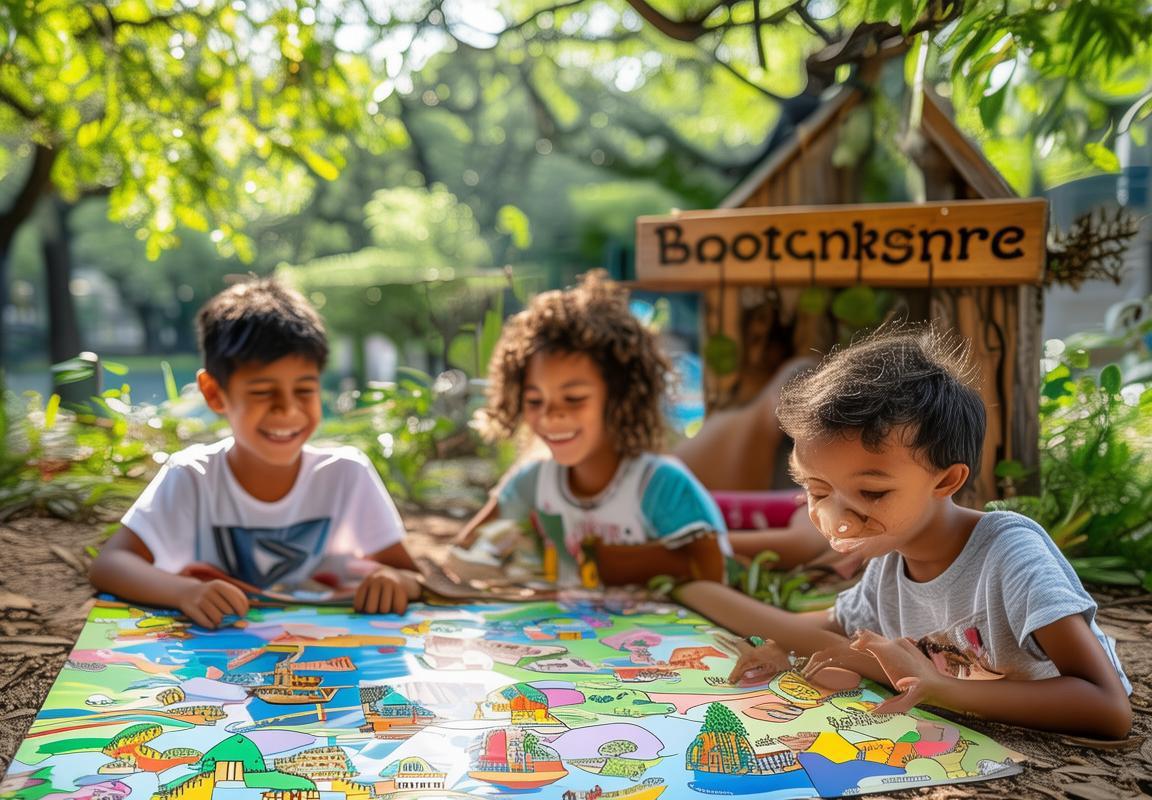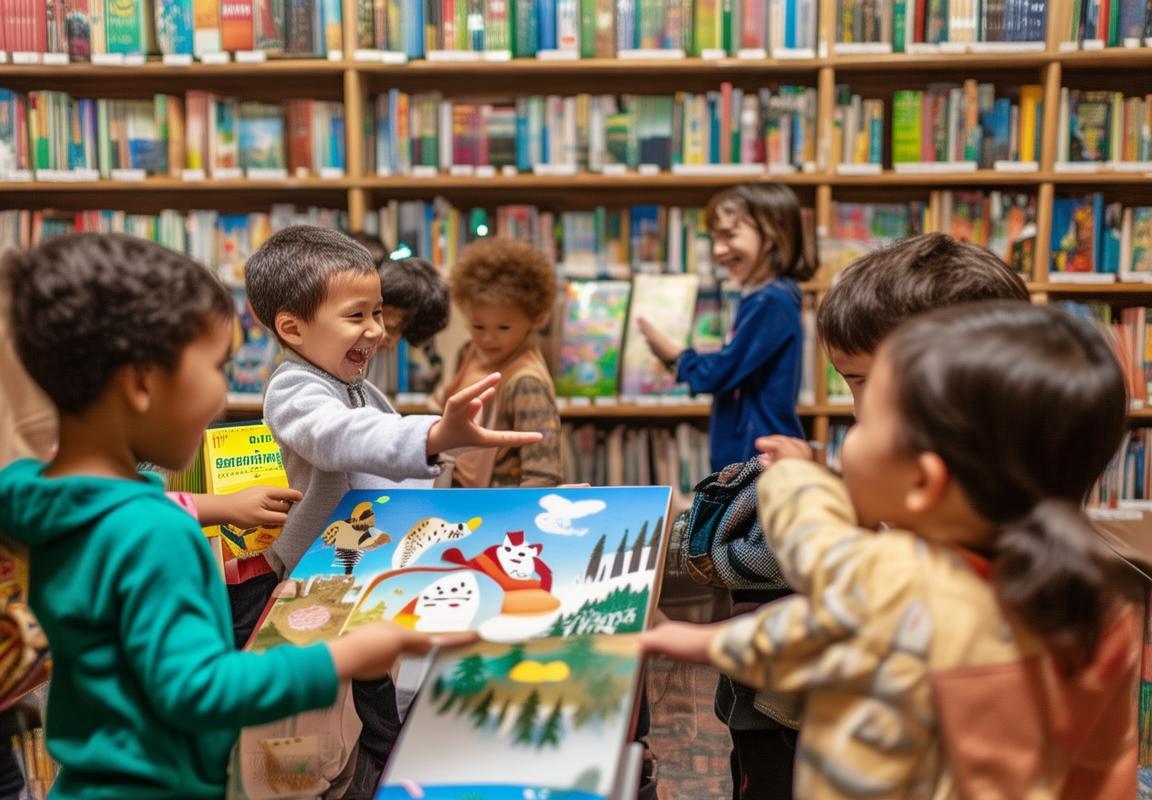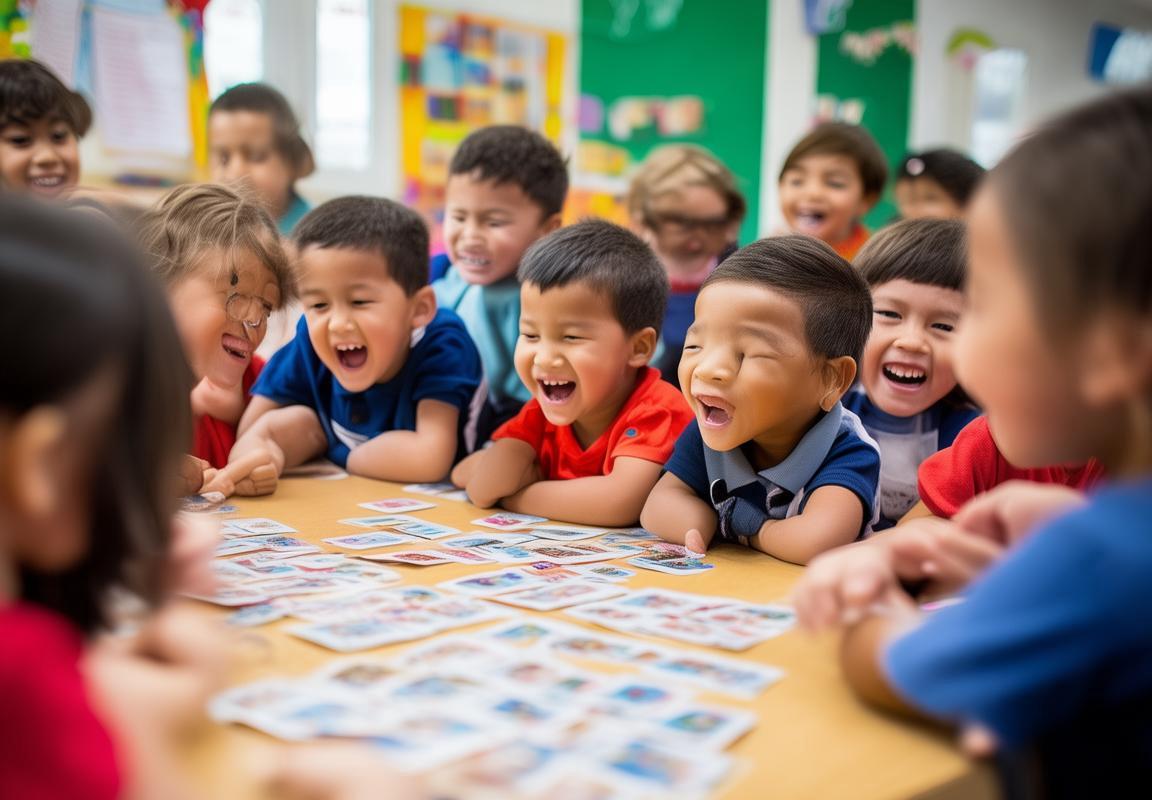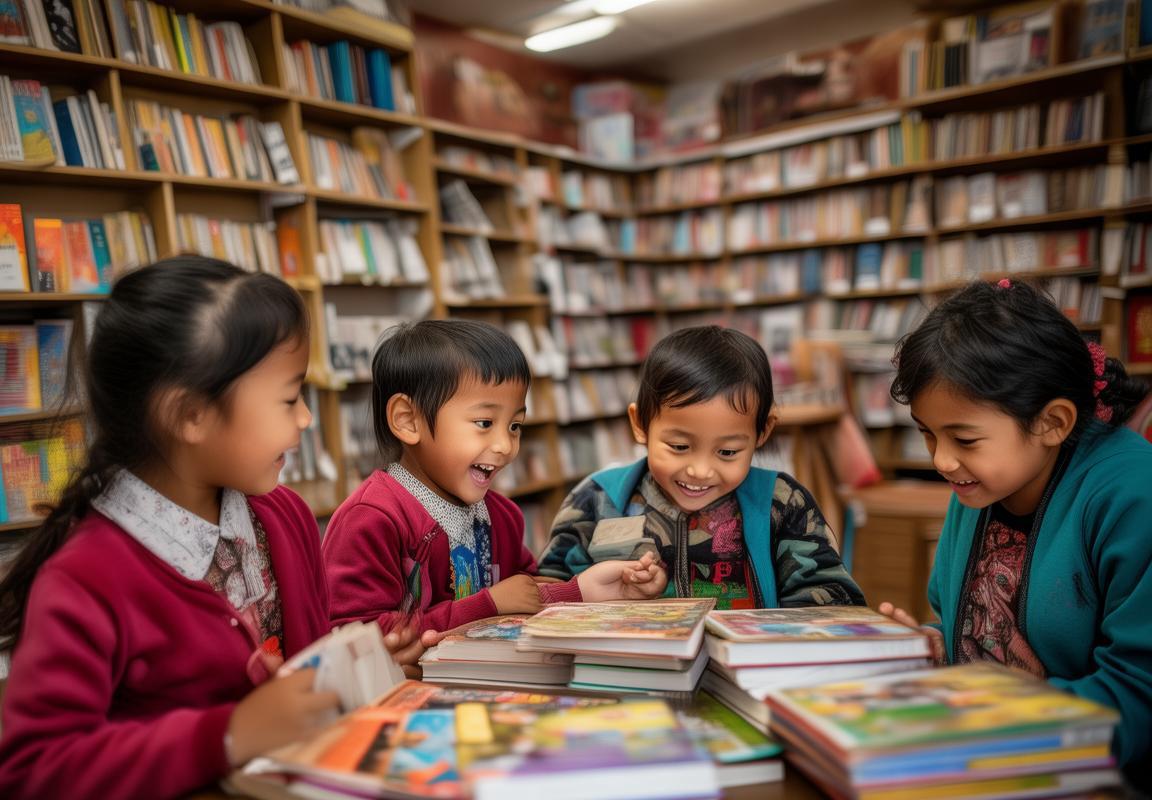เรากำลังจะนำเสนอเนื้อหาเรียนรู้ที่น่าสนใจและมีประโยชน์สำหรับเด็กๆอายุ 4-5 ปี โดยใช้ภาพสัตว์น้ำเป็นตัวช่วยในการเรียนเขียนตัวอักษรภาษาอังกฤษ นี่จะเป็นประเด็นที่เด็กๆสามารถเรียนเรียบร้อยและมีสนุกสนานด้วยเด็ดขาด!
หน้าที่1:การเข้าสู่ร้านหนังสือ
In the bustling city park, there’s a playful game where children can find hidden words related to their surroundings. Here’s how the game is played:
-
Prepare the Game Board: Create a board with pictures of objects that are commonly found in the park, such as trees, swings, slides, a pond, and other park elements.
-
Hide the Words: Write words related to the park on small pieces of paper, such as “tree,” “swimming,” “slides,” “pond,” and “sun.”
-
Set Up the Game: Place the game board on the ground and spread out the hidden words nearby.
-
Start the Game: The children take turns searching for the hidden words while saying the word in English. For example, if they find a “tree,” they say “tree” in English.
-
Collecting Points: Each time a child finds a word, they collect the corresponding piece of paper. The child who collects the most words at the end of the game wins.
-
Vocabulary Review: After the game, review the words found, and discuss what they mean. This helps reinforce the children’s vocabulary.
-
Fun and Learning: Encourage the children to use the words in sentences, such as “I like to swing on the swings” or “There are many trees in the park.”
-
Repeat and Extend: Play the game multiple times to introduce new words and concepts, and to improve the children’s English skills.
By playing this game, children not only have fun exploring the park but also learn new English words related to their environment.

หน้าที่2:ติดต่อประชาสัมพันธ์กับพนักงานร้าน

หน้าที่ 2: ติดต่อประชาสัมพันธ์กับพนักงานร้าน
เด็กๆ แต่ละคนยืนขึ้นมาและเริ่มที่จะพูดกับพนักงานร้านอย่างกล้าหาญ ดังนี้:
เด็ก 1: “Excuse me, where are the children’s books?”
พนักงานร้าน: “They are on the second shelf from the left, just past the section for adult fiction.”
เด็ก 1: “Thank you very much!”
เด็ก 2: “Hello! Can you show us where the picture books are?”
พนักงานร้าน: “Certainly! Follow me, they are right over here.”
เด็ก 2: “That’s great! We’re looking for books with colorful pictures.”
พนักงานร้าน: “I see. There are many beautiful books here. Do you have any preferences, like animals or fairy tales?”
เด็ก 3: “We like books about animals!”
พนักงานร้าน: “Excellent! I’ll show you the section for children’s books about animals.”
เด็ก 3: “Thank you!”
เด็ก 4: “May I ask how much this book costs?”
พนักงานร้าน: “Of course. This book is $5.”
เด็ก 4: “How do I pay for it?”
พนักงานร้าน: “You can pay with cash or a card. Which would you prefer?”
เด็ก 5: “I’ll pay with my allowance.”
พนักงานร้าน: “Perfect! Here you go, and enjoy your new book!”
เด็ก 5: “Thank you!”
เด็กๆ ก็กลับไปที่โลกของตนเองและกล่าวกันว่า “We just bought a new book! It’s about animals!”
พนักงานร้านดูแลเด็กๆ โดยให้คำแนะนำและช่วยเหลือในการเลือกหนังสือที่เหมาะสม และเด็กๆ ก็ได้รับความสุขในการซื้อหนังสือของตนเอง โดยเข้าใจถึงกระบวนการการซื้อของในร้านหนังสืออย่างเป็นที่สำคัญและเพื่อนุญาติ

หน้าที่3:การเลือกหนังสือ
หน้าที่ 3: การเลือกหนังสือ
เด็กๆ ทั้งหลายกำลังอยู่ในร้านหนังสือ และความคืบเคราะห์ของพวกเขาสูงขึ้นเมื่อพวกเขาเห็นหนังสือหลากหลายที่ตกอยู่บนชั้น. อาจารย์ยืนอยู่ข้างหนึ่งและกล่าว:
“เด็กๆ ทุกคน จะมีโอกาสเลือกหนังสือหนึ่งที่พวกเขาชอบ. พวกเขาอาจเลือกหนังสือที่มีภาพสวยงามหรือหนังสือที่มีเรื่องราวที่สนุก.”
เด็กๆ 1 ตะโกนขึ้นและกล่าว:
“ฉันชอบหนังสือที่มีภาพแมว! มันเหมาะสำหรับฉันเพราะฉันชอบแมว.”
อาจารย์ยกมือขึ้นและกล่าว:
“ดีมากที่คุณชอบแมว! มีหนังสือที่มีภาพแมวหรือเรื่องราวเกี่ยวกับแมวหรือไม่?”
เด็กๆ 2 ตะโกนขึ้นกลับ:
“ฉันชอบหนังสือที่มีภาพหมอมัน! มันเหมาะสำหรับฉันเพราะฉันชอบหมอมัน.”
อาจารย์ยืนอยู่ดูและกล่าว:
“น่าจะสนุกที่จะอ่านหนังสือที่มีภาพหมอมันด้วย. พวกเขาเจอหมอมันทุกที! มีหนังสือที่มีภาพหมอมันหรือไม่?”
เด็กๆ 3 กลับมากลางและกล่าว:
“ฉันชอบหนังสือที่มีภาพป่า! มันเหมาะสำหรับฉันเพราะฉันชอบป่า.”
อาจารย์ยกมือขึ้นและกล่าว:
“ป่าเป็นที่ที่น่าสนุกเพื่อตัวอ่อน! มีหนังสือที่มีภาพป่าหรือไม่?”
เด็กๆ 4 กลับมากลางและกล่าว:
“ฉันชอบหนังสือที่มีภาพทะเล! มันเหมาะสำหรับฉันเพราะฉันชอบทะเล.”
อาจารย์ยืนอยู่ดูแลและกล่าว:
“ทะเลเป็นที่ที่น่าสนุกที่สุด! มีหนังสือที่มีภาพทะเลหรือไม่?”
เด็กๆ ทุกคนกำลังอยู่ภายในกระเป๋าหนังสือและตั้งต่อตนเองเลือ

หน้าที่4:การแจกแจงหนังสือ
หน้าที่ 4: การแจกแจงหนังสือ
เด็กๆ แต่ละคนถูกแบ่งเป็นกลุ่มเล็กๆ และมีคนหนึ่งตั้งให้เป็นผู้จัดการกลุ่มของเขา อาจารย์จะให้หนังสือต่างๆ มาในตัวช่วยสำหรับเกมจับคู่ภาษาอังกฤษ
-
อาจารย์: “Let’s start our game. I have some pictures of animals here. You need to find the matching words that describe them.”
-
เด็กๆ 1: “This is a picture of a cat. What is the word for cat in English?”
-
อาจารย์: “That’s right! The word for cat is ‘cat.’ Now, can you find the word for this picture?”
-
เด็กๆ 2: “This is a dog. The word for dog is ‘dog.’”
-
อาจารย์: “Great job! Now, let’s try another one. What is this picture?”
-
เด็กๆ 3: “This is a fish. What do we call this in English?”
-
อาจารย์: “Exactly! The word for fish is ‘fish.’ Can you find the word for this picture?”
-
เด็กๆ 4: “This is a bird. The word for bird is ‘bird.’”
-
อาจารย์: “Well done! Each time you find the correct word, you get a point. The team with the most points at the end wins.”
-
เด็กๆ 5: “We want to win!”
-
อาจารย์: “I’m sure you will. Let’s continue and have fun learning new words.”
เมื่อเกมจบลง อาจารย์จะนับคะแนนและเสนอให้เด็กๆ อ่านหนังสือที่เขาเลือกไปด้วยตัวเอง หรืออาจารย์จะอ่านเสียงแก่เด็กๆ จนกระทั่งทุกคนสามารถเข้าใจเรื่องที่อ่านไปแล้ว
-
อาจารย์: “Now that we’ve finished our game, let’s read our books together. I’ll read the story, and you can follow along.”
-
เด็กๆ 6: “I like this book!”
-
อาจารย์: “I’m glad to hear that. Let’s enjoy the adventure together.”

หน้าที่5:การจ่ายเงินและเอาหนังสือออกไป
หน้าที่ 5: การจ่ายเงินและเอาหนังสือออกไป
เด็กๆ 1: “Okay, let’s go to the counter to pay for our books.”เด็กๆ 2: “How much does each book cost?”เด็กๆ 3: “The shopkeeper said each book costs $5.”
เด็กๆ 1: “So, we need to pay $5 for each book. How many books do we have?”เด็กๆ 2: “We have two books.”เด็กๆ 3: “That means we need to pay $10 in total.”
เด็กๆ 1: “Let’s count the money together. I have five dollars, and you have five dollars.”เด็กๆ 2: “I have five dollars too!”เด็กๆ 3: “Together, we have ten dollars.”
เด็กๆ 1: “Now, we can give the money to the shopkeeper. Excuse me, how do we say ‘ten dollars’ in English?”เด็กๆ 2: “It’s ‘ten dollars’.”เด็กๆ 3: “Let’s say it together: ‘Ten dollars, please.’”
เด็กๆ 1: “Here you go, ten dollars. Thank you!”เด็กๆ 2: “The shopkeeper says ‘Thank you’ and gives us the books.”เด็กๆ 3: “Look, we have our books! Let’s take them back to the classroom and start reading.”
เด็กๆ 1: “Remember, we learned how to buy books at the bookstore and how to count money. It’s fun to read new books together!”เด็กๆ 2: “Yes, let’s read our books now!”
เด็กๆ 1: “And don’t forget to say ‘Thank you’ to the shopkeeper when we leave.”เด็กๆ 2: “Thank you!”เด็กๆ 3: “Bye-bye, shopkeeper!”
เด็กๆ 1: “Now, let’s go back to the classroom and share our new adventure with our friends.”

หน้าที่6:การสรุป
หน้าที่ 6: การสรุป
แล้วเสร็จแล้วทุกกิจกรรม! วันนี้เราได้เรียนรู้อะไรมากมายเกี่ยวกับภาษาอังกฤษและมันเป็นสิ่งที่ดีที่เราจะใช้มันในการสนทนากับเพื่อนๆ หรือเมื่อเราอยู่ที่โรงเรียนหรือในห้องสมุดหรือแม้แต่เมื่อเราไปเที่ยวต่างประเทศด้วยเลยเลย! ก่อนที่เราจะเดินทางกลับบ้าน นี่คือบางอย่างที่เราได้ทำวันนี้:
- การแชทกับสัตว์เลี้ยง: เราได้สนทนากับสัตว์เลี้ยงโดยใช้ภาษาอังกฤษ และเรารู้จักกันมากขึ้นเกี่ยวกับวิญญาณของมัน!
- วันที่และเวลา: เราได้เรียนรู้ว่าวันที่และเวลาดูอย่างไรในภาษาอังกฤษ และเรายังได้สัมผัสกับเรื่องราวการเดินทางด้วย!
- สีของสิ่งแวดล้อม: เราได้ประกอบกันเขียนเรื่องราวที่มีสีสวยงามและสนุกสนาน!
- การเขียนตัวอักษร: เราได้เล่นเกมที่ช่วยเรียนรู้ตัวอักษรและเสียงของมันด้วยทางง่ายๆ!
- การเดินทาง: เราได้ประกอบกันเล่าเรื่องเล่าเล็กๆ ที่มีการผจญภัยในป่าหรือทะเล!
- สัตว์บกและสัตว์น้ำ: เราได้เรียนรู้เกี่ยวกับสัตว์ที่อาศัยอยู่บนและใต้น้ำ!
- การทำความสะอาด: เราได้สร้างบทสนทนาเกี่ยวกับการทำความสะอาดบ้านและดูแลตัวเอง!
เราทำงานอย่างดีและเรารู้จักกันมากขึ้นเกี่ยวกับภาษาอังกฤษแล้ว! อีกครั้งขอบคุณที่มาเรียนกับเราและเราก็ขออภัยถ้ามีอะไรที่เรายังไม่เข้าใจ! กำลังมือกันไปเรียนรู้ภาษาอังกฤษมากขึ้นอีกครั้งในวันหน้าน
